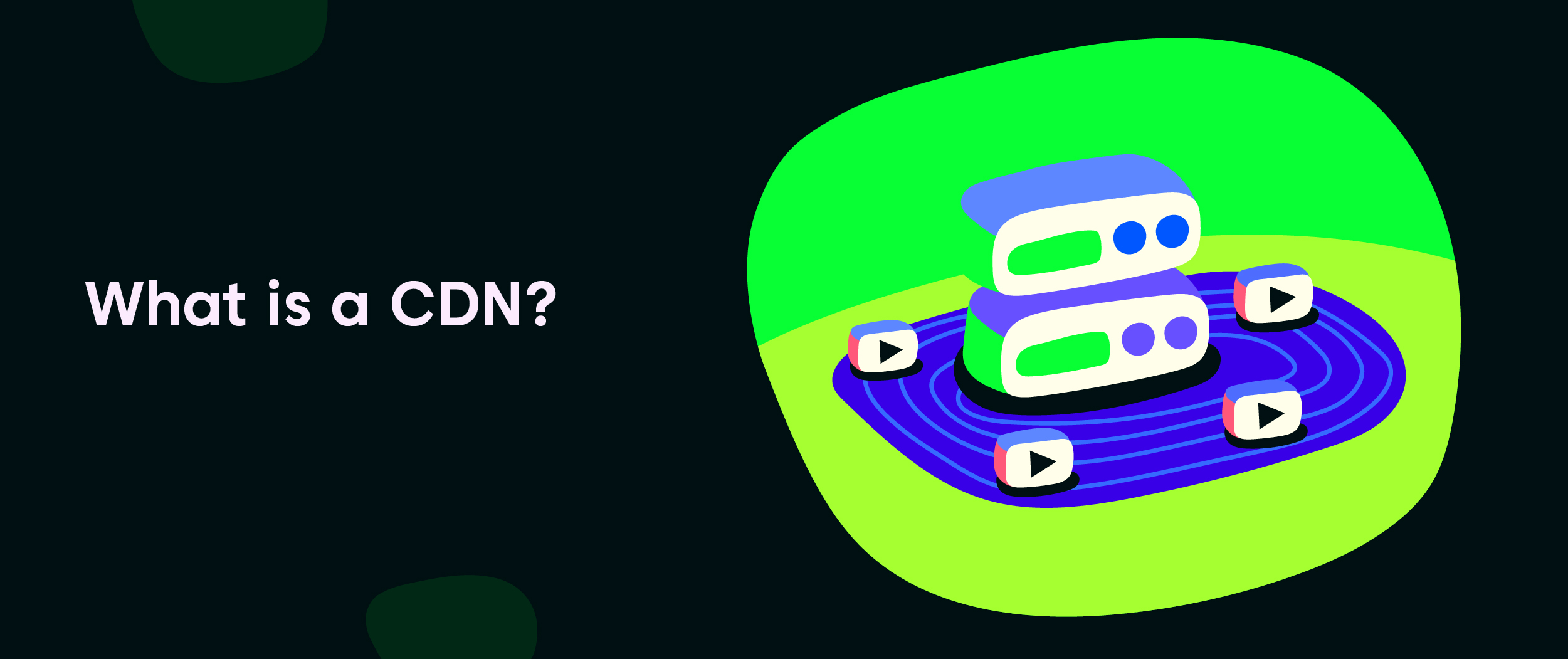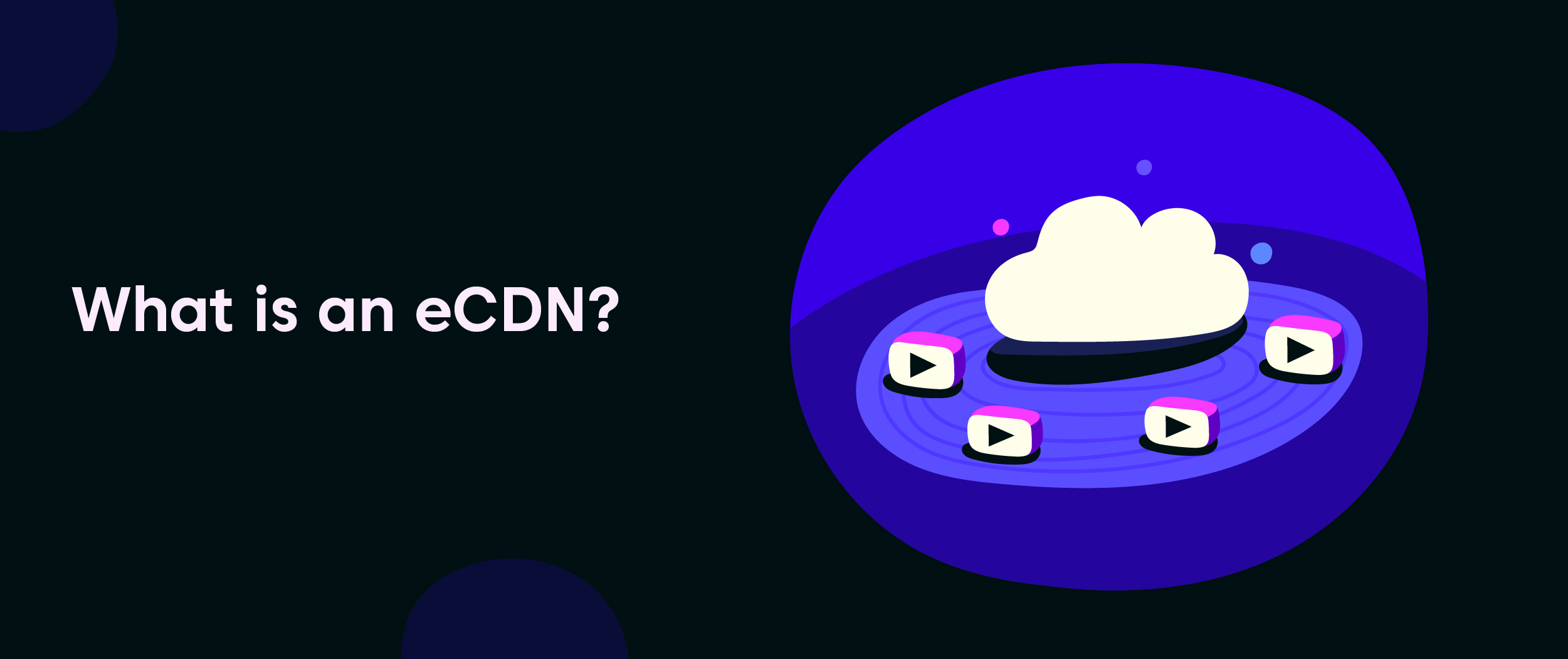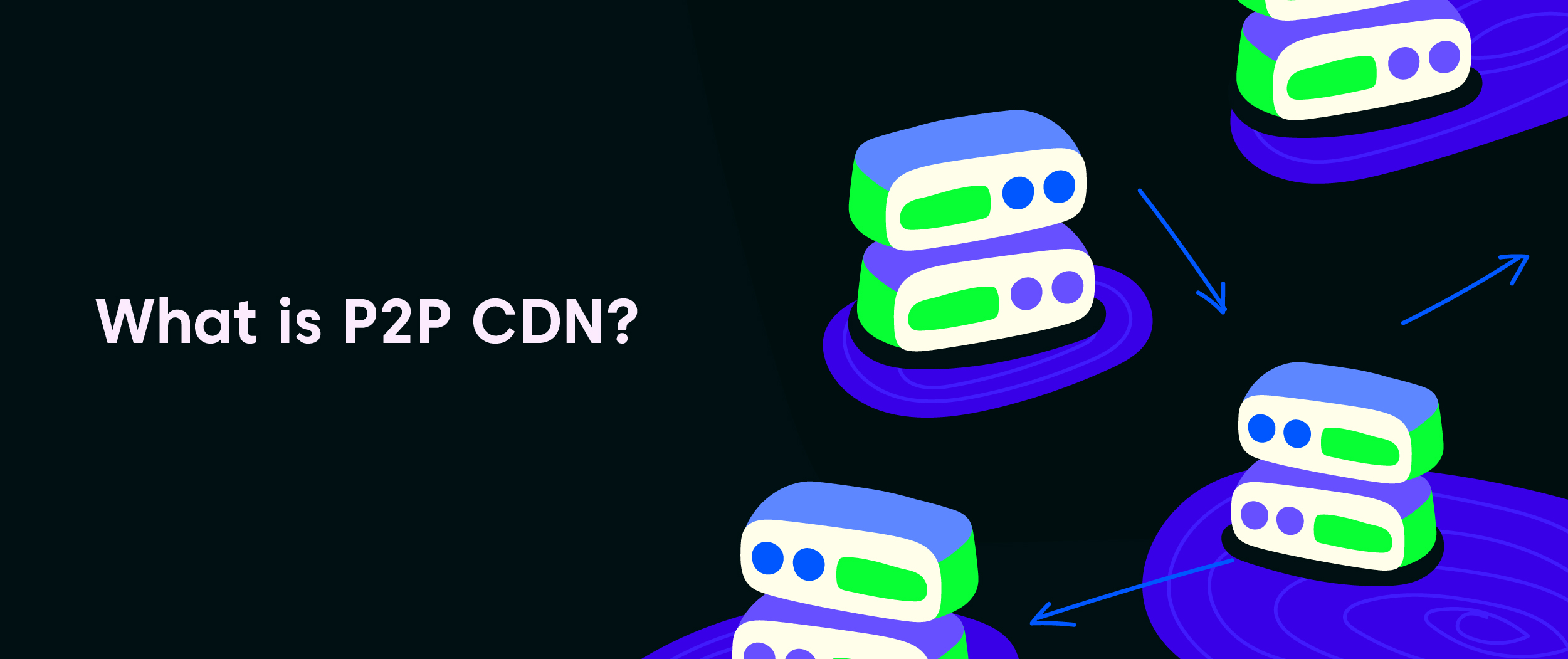eCDN (Enterprise Content Delivery Network) or P2P CDN (Peer-To-Peer Content Delivery Network)
What is A Content Delivery Network (CDN)?

A content delivery network (CDN) is a crucial component in today’s digital landscape. A content delivery network (CDN) may be defined in more detail, though. A content delivery network (CDN) is essentially a network of servers positioned strategically all over the world to deliver content, such as videos, to users effectively and instantly.
CDNs, whether for enterprise or general use, work by distributing content delivery across various servers. When a user requests a video stream, the CDN selects the server closest to their location, allowing for faster access. This not only improves video performance but also reduces the strain on the origin server, local area network, and corporate network.
Furthermore, CDNs are designed to overcome potential hurdles such as corporate firewalls. By fully integrating with the existing network infrastructure, they enable live streaming and on-demand content delivery even in secure corporate environments. This means that important live events, like town halls or external CDN broadcasts, can be delivered seamlessly to employees across different locations.
What Are The Benefits of Using A CDN?
The benefits of implementing a CDN for video distribution are numerous. By optimizing load distribution, CDNs reduce bandwidth requirements and minimize the impact of high-demand video traffic on a company’s network. Moreover, CDNs improve the overall viewing experience for users, ensuring high-quality video delivery regardless of their location or the devices they use to access the content.
To sum it all up, a content delivery network (CDN) is a distributed network of servers that efficiently delivers video and other content to users worldwide. By leveraging strategic server locations and load distribution techniques, CDNs optimize video quality, reduce bandwidth requirements, and enable the seamless delivery of live events across the globe.
What Is An Enterprise Content Delivery Network (eCDN)?

An enterprise content delivery network (eCDN) is a powerful solution that enhances video streaming and content delivery within corporate networks. But what exactly is an eCDN? In simple terms, an eCDN is a specialized content delivery network designed to optimize video performance and quality for live video streaming and video content delivery.
Traditional content delivery networks deliver video streams from external CDNs to users, often causing strain on bandwidth and network capacity. With an eCDN, the video stream is delivered within the corporate network, eliminating the need for external CDNs and enabling high-quality video delivery without consuming additional internet bandwidth.
eCDNs leverage edge servers strategically placed within the corporate network, allowing users to access live broadcasts and video streams with minimal latency and optimal video quality. By fully integrating with the existing infrastructure, eCDNs bypass corporate firewalls and securely deliver content directly to viewers.
The benefits of an enterprise content delivery network are manifold. For example, during live events such as town halls or company-wide broadcasts, eCDNs ensure smooth and uninterrupted streaming, even with a large number of concurrent viewers. By reducing external traffic and optimizing server load, eCDNs enable businesses to create a seamless video experience for employees across different locations.
In summary, an enterprise content delivery network (eCDN) is a platform that leverages internal network connections to deliver video content efficiently, enhancing video performance and minimizing the strain on bandwidth and external CDNs. By utilizing edge servers strategically placed within corporate networks, eCDNs provide high-quality video streaming while ensuring security and optimal load distribution. Whether it’s for live events or day-to-day video delivery, an eCDN is an essential tool for businesses to enable seamless video access for their users across the enterprise.
Why Use An eCDN?
Why use an eCDN? An enterprise content delivery network (eCDN) offers numerous advantages for live video streaming and video content delivery. Traditional content delivery networks (CDNs) may find it challenging to manage the required network capacity due to the growing demand for high-quality video content and the requirement to reach a wide spectrum of consumers. However, an eCDN leverages the existing corporate network infrastructure, including local area networks (LANs), to deliver content efficiently. By using edge servers strategically placed within the corporate networks, eCDN enables the same stream to be delivered simultaneously to multiple users without overwhelming the company’s internet connection. This fully integrated approach ensures optimal video performance, mitigates bandwidth congestion, and maintains video quality even during peak traffic.
What Are the Benefits of Using An eCDN?
One of the key benefits of using an eCDN is the enhanced security it provides. As video streams are delivered within the corporate network, behind the company’s firewall, sensitive data remains protected. This is particularly crucial for live broadcasts of internal town halls or other live events where companies want to restrict access to authorized viewers. By avoiding the need to rely solely on external CDNs, which may introduce potential vulnerabilities, eCDN ensures a secure and controlled video distribution within the company’s own connections.
In addition to security, an eCDN offers scalability and flexibility. Enterprises with multiple locations can create a robust video delivery network by leveraging their existing infrastructure and enabling video streaming across different sites. Whether it’s for training sessions, company-wide announcements, or global meetings, eCDN optimizes the delivery of video content and reduces the strain on external servers. By distributing video streams locally, businesses can provide seamless access to high-quality video for employees worldwide, regardless of their physical location or the devices they use.
To summarize, using an eCDN addresses the challenges of delivering high-quality video content in an efficient and secure manner. By utilizing the corporate network, eCDN leverages existing resources, ensuring optimal video performance, and reducing the strain on external servers. It enables companies to deliver video content seamlessly to a large number of users across different locations while maintaining the security of sensitive data. Whether for live events, internal video streaming, internal communications, or training purposes, an eCDN provides the necessary infrastructure and scalability to meet the demands of today’s video-driven world.
CDN vs. eCDN (The difference between a CDN and an eCDN)

Businesses have two options to think about: CDN and eCDN, when it comes to efficiently delivering high-quality video content. An international network of servers that are strategically positioned serves as a content delivery network (CDN). By lowering latency and optimizing bandwidth usage, it aims to enhance video performance and quality. CDNs excel in serving video streams to users across the internet, ensuring smooth playback and reducing the load on the origin server.
An Enterprise Content Delivery Network (eCDN), on the other hand, is designed specifically to meet the requirements of corporate networks, including local area networks (LANs). eCDNs enable seamless video streaming within a corporate firewall, allowing employees to access live broadcasts and on-demand video content without impacting external CDN traffic. By leveraging the existing network infrastructure, eCDNs ensure efficient video distribution, even during high-demand events like town halls or live events.
The key difference between CDN and eCDN lies in their target audiences and network capacities. While CDNs are optimized for delivering video content to a wide range of users across the world, eCDNs focus on enhancing video performance within a corporate environment. By integrating with the existing infrastructure, eCDNs minimize bandwidth consumption and ensure secure video delivery to employees in different locations.
In line with the use case, CDNs and eCDNs provide distinctly different advantages. The best option for companies looking to provide high-quality video streaming to a global audience is a CDN. They create a reliable connection between the origin server and viewers, optimizing load times and reducing data consumption. On the other hand, eCDNs are tailored for enterprises with multiple locations, ensuring smooth video playback and minimizing strain on the company’s network during live events or large-scale video distribution.
In summary, CDNs and eCDNs serve different purposes in the realm of video content delivery. CDNs deliver content to users worldwide, optimizing performance and load times. In contrast, eCDNs enable seamless video streaming within corporate networks, enhancing video quality and reducing strain on the infrastructure. By understanding the distinction between these two technologies, businesses can choose the right solution to meet their specific requirements and deliver an exceptional video experience to their customers and employees.
What is P2P CDN (Peer-To-Peer Content Delivery Network)?

A P2P CDN, also called a peer-to-peer content delivery network, distributes content using a peer-to-peer architecture. P2P CDNs utilize a network of distributed nodes to share and cache content, in contrast to traditional CDNs, which depend on centralized servers to deliver content to users. The load is distributed among multiple nodes rather than being concentrated on a few centralized servers, enabling more rapid and efficient content delivery.
P2P CDNs can utilize the resources of individual users’ devices to help spread the content, making them particularly useful for delivering large files like video streams or software downloads. P2P CDNs do have a few drawbacks too, including concerns over security and the potential for slower initial load times because nodes must connect to one another. P2P CDNs offer an innovative approach to content delivery that, in some circumstances, can be of significant benefit.
The Importance of P2P CDN for Content Delivery and OTT Video Streaming
P2P CDN, or peer-to-peer content delivery network, is a super cool way to deliver stuff and stream videos. It’s not like those old-school CDNs that use big boss servers. P2P CDN is all about teamwork and sharing. It’s like having a whole bunch of nodes spread out everywhere, working together to send and receive content. And guess what? It’s super-fast and reliable, plus it saves money on bandwidth for content providers. Pretty awesome, right?
There’s more! P2P CDN isn’t just good for delivering content. It’s a game-changer for streaming videos, especially those fancy OTT ones. By using P2P tech, those OTT providers can make buffering a thing of the past and give their users the best viewing experience ever. You know, with all the high-quality stuff and no annoying pauses.
All in all, P2P CDN is a big deal for content providers and OTT video streaming services. It helps them deliver things better and make users happier. And with technology always changing, who knows what the future holds for P2P CDN? Exciting times are ahead!
Revolutionize Your Streaming With Castr’s P2P CDN Solution
Castr’s P2P CDN service harnesses the power of distributed networks, allowing you to distribute your content efficiently to a global audience.
By leveraging the strength of peer-to-peer connections, Castr’s P2P CDN service ensures lightning-fast content delivery with reduced latency. Whether you’re streaming live events, video on demand, or large files, Castr’s P2P CDN solution guarantees optimal performance and reliability.
With Castr’s P2P CDN service, you can scale effortlessly to accommodate growing viewership without compromising on quality. The intelligent network routing algorithms automatically select the most efficient path for content delivery, optimizing your streaming experience.
Don’t let slow streaming hold you back. Choose Castr’s P2P CDN solution and unlock the full potential of your streaming platform. Experience the future of streaming today with Castr’s revolutionary P2P CDN service.
What is The Difference Between eCDN and P2P CDN?
Two terminologies that frequently appear while considering content delivery networks (CDNs) are eCDN and P2P CDN. So, what is the difference between eCDN and P2P CDN? Let’s dive in!
eCDN, or enterprise content delivery network, is designed for organizations that require efficient internal video streaming. It optimizes bandwidth usage by delivering video content from a central server to multiple endpoints within the organization’s network.
In contrast, P2P CDN, or peer-to-peer content delivery network, leverages the collective resources of connected devices to distribute content. It creates a decentralized network where devices share the load by delivering and receiving content from one another. This reduces strain on the central server and enhances scalability.
To sum it up, while eCDN focuses on internal video delivery within an organization, P2P CDN harnesses the power of interconnected devices for efficient content distribution. Finding the right approach for your unique needs requires an understanding of the differences between these two CDNs.
Why Do Content Delivery Networks Matter?
Content delivery networks (CDNs) play a vital role in the online world. But why do content delivery networks matter? Well, they are crucial for ensuring fast and reliable content delivery to users across the globe.
CDNs act as a distributed network of servers strategically placed in various locations worldwide. By storing cached copies of website content, including images, videos, and scripts, CDNs reduce latency and enhance website performance. This optimization directly impacts user experience, as faster-loading websites lead to lower bounce rates and increased engagement.
Moreover, content delivery networks help websites handle high traffic volumes during peak periods, preventing server overloads and downtime. In summary, CDNs are indispensable for maximizing website speed, availability, and user satisfaction.
CDN vs eCDN – Which Content Delivery Network is Right for You?
Businesses frequently have to choose between an enterprise CDN (eCDN) and a traditional CDN when it comes to content delivery networks (CDNs). CDN vs eCDN – Which Content Delivery Network is Right for You? This question is pivotal for optimizing content delivery and enhancing user experience.
A CDN is a widely-used solution that caches and distributes website content across multiple servers globally, reducing latency and improving load times. On the other hand, eCDN caters specifically to large organizations, providing advanced features such as secure internal streaming, bandwidth optimization, and scalability. Choosing the right CDN or eCDN depends on factors like your organization’s size, specific needs, and budget.
The Challenge with Video Delivery for Enterprise
The challenge with video delivery for enterprises is a critical aspect of modern business operations. In today’s digital landscape, where visual content dominates online platforms, enterprises face numerous hurdles when it comes to effectively delivering videos.
One of the primary challenges lies in ensuring seamless streaming and high-quality playback across various devices and network conditions. Enterprises must optimize their video delivery infrastructure to overcome bandwidth limitations and latency issues, providing a smooth viewing experience for users. Additionally, the scalability of video delivery systems is crucial as enterprises often deal with a large volume of content.
By implementing robust solutions and leveraging advanced technologies, businesses can tackle the challenge of video delivery for enterprises, enhancing their online presence and engaging their target audience effectively.
Conclusion (Scaling Enterprise Video Delivery in 2023 and Beyond)
In 2023 and beyond, scaling enterprise video delivery has become a paramount concern for organizations seeking to enhance their digital presence. Adopting an effective eCDN (Enterprise Content Delivery Network) or P2P CDN (Peer-To-Peer Content Delivery Network) has become extremely vital given the exponential growth in the consumption of video content. These advanced solutions ensure optimized video delivery by leveraging a distributed network architecture.
By strategically placing eCDN or P2P CDN nodes across the organization’s infrastructure, video content is delivered seamlessly to end-users, regardless of their location. This not only reduces bandwidth strain but also improves video streaming quality, reducing buffering issues. Embracing eCDN or P2P CDN technology is a game-changer, empowering enterprises to meet the escalating demands of video delivery and provide a superior user experience.







